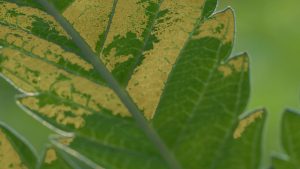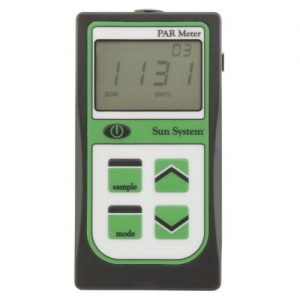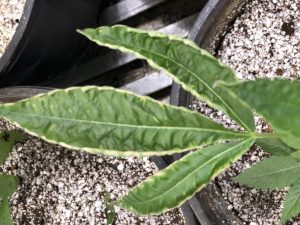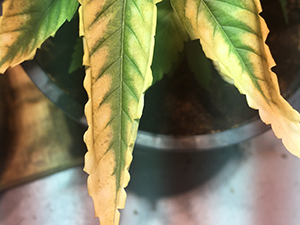Understanding Cannabis Light Burn
Symptoms
When you notice your cannabis plants starting to turn yellow or otherwise exhibit signs of stress on the leaves that are the closest proximity to the source of light and/or heat, it is possible you have light burn. You may also notice your leaf curling into a tube or rolling over, showing the underside of the leaf, shading itself from the light source.

Whatever the symptoms are, it is possible that the problem is that the lighting fixture is too close to the canopy. The obvious solution would then be to move it up to the correct height and see if the problem persists. If it does then you may have to look at other factors including environment, disease, or nutrient deficiency.
So the question we really want to answer is… what should be the correct height of a lighting fixture over a cannabis plant?
 It is important to take the time to understand the proper height so you will never need to worry about treating plant burn again.
It is important to take the time to understand the proper height so you will never need to worry about treating plant burn again.
If we go back to Season 1 Episode 11 of Growing Exposed, Joe who co-owns Treedom explained how he likes to use a PAR meter to adjust his lighting fixtures to the correct height. PAR (Photosynethically Active Radiation) meters measure light intensity within the spectrum that plants use most to photosynthesize from 400 to 700 nanometers, which covers both the blue and red spectra of light. So you can use a par meter to measure how well your lights are covering your grow footprint and adjust your light setup accordingly.
I filmed a short segment and uploaded it to our YouTube channel of Rob VanDiest from Grow Rebates, who has set up thousands of lights from all different manufacturers, explaining to me his process. He mentions the obvious factor that plants are looking for the optimal amount of light.
So what is the optimal amount? Rob shows in the video below that he does this by raising a light meter placing it right on top of the canopy and measuring it. And he ads “Every week this should be done if you would like to keep it in the optimal range.”
Optimal Range
Rob does his first measurement over plants which have just been moved over to the flower room and says “they should be no less than 400 micromoles in flower” and adds that “having it around 500 micomoles is a good place.” Keep in mind this is only for the first few weeks. As the plants mature and grow into the lights he recommends “800-900 micro moles anything after 3 weeks.”
Step 1 – Grab a PAR meter and place it at the top of the canopy.
Step 2 – Raise or lower your light until it falls in the recommended range. (800-900 for anything after 3 weeks)
Need a PAR meter?
Check out the Sun System PAR Meter which comes with a integrated sensor to measure photosynthetic active radiation (PAR). Designed to measure the intensity of grow lights or outside with natural sunlight. Simple and easy to use. Compact size with integrated sensor.

To back this up I will also point to one of the leaders in the industry, Gavita Holland who has a white paper on their website that says a novice grower can be growing in the 7-800 μmol s-1 m-2 average or less, for a savvy grower using CO2 this can be more than 1000 μmol s-1 m-2.
So if you consider yourself a savvy growers experiment by boosting your fixtures for higher levels.
Leaf Curl Caused By Intense Light
If you notice leaf curl for young plants and why is it doing this? Essentially the petal is shading itself reducing the amount of light that is striking the photosynthesis area. By reducing the amount of light striking the photosynthesis area, we see a reduced need for water.
The plant is protecting itself from the transpiration rate that is being induced by the lighting. So under what circumstances does this happen? Sometimes we have a young plant that we have just transplanted. We’ve taken it away from its gentle fluorescent lighting. We’ve now put it under HID lighting, which is more intense, demanding a greater rate of transpiration, and the plant is young. It hasn’t established an aggressive root mass yet.
Leaf Curl Solution
You could back the lights off, so it’s not as intense. You could also raise the humidity a bit, but at the end of the day, this is not a serious problem. Root curl his is really one of the easiest problems you could deal with. All you need to do is let that root mass dry out. In other words, don’t overwater it because as the root mass dries out, the roots are really going to rip through that medium and establish their size. Then the next time you water that medium like if you use a root stimulator, you’re going to have much more root growth in that medium to take up the water that you’re giving it, which will then match the above ground rate of transpiration. They will definitely grow out of this minor problem.
If you would like to know more about leaf curl caused by intense light check out this video I made a video a few years ago with David Robinson about this topic.
.
Cannabis light burn usually affects the top leaves closest to the grow light. Plants have been growing under the scorching sun for thousands of years but too intense and they can turn to a crisp. It is unlikely for your plants to get “light-burned” from the sun when growing outdoors in general cannabis plants like a lot of light.
How can there be too much light if there’s no heat with LED lighting?
 The reason is the yellowing leaves and brown edges/tips are caused by LED grow light burn. This is the reason why we measure micromoles to determine the light height is because the intensity and heat is very different for lights.
The reason is the yellowing leaves and brown edges/tips are caused by LED grow light burn. This is the reason why we measure micromoles to determine the light height is because the intensity and heat is very different for lights.
All rooms are different. So if your friend has the same brand of lights don’t assume it will be exactly the same in your room. Because light is reflected from the walls, the ceiling, and even the floor and no 2 set ups are the same.
Keep in mind…If your plant is also having other problems, it is much more likely to be affected by light burn. A healthy plant can withstand higher light levels than a sick plant.
If the lights are only slightly too close, maybe just an inch or a few cm, the yellowing from light burn may happen slowly over the course of days (or even weeks!) because leaves are dying early instead of immediately. Because of that, light burn may first appear on somewhat older leaves, which can be confusing and make it hard to diagnose..
Most of the Time, Light-Burned Buds Appear Burnt
Other Options: If your marijuana plants are getting too much light, try removing some of the lights or moving your grow lights further away from the tops of the plants. If you can’t move the light further away, bend your plants over so the tops are further away or if your plant is still in the vegetative stage you might even consider “topping” the plant to remove some of that height.
Some lights allow you to reduce the power of the grow lights if it is not possible to move them further away from your cannabis plant
Check out the entire series of Growing Exposed here.
Happy Growing



